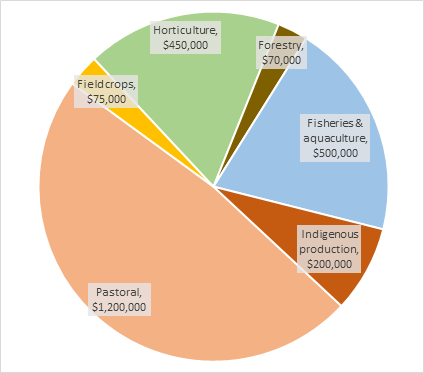Executive Summary
The Northern Hub region occupies a third of Australia. The annual production from land and water resources is estimated at $2.45 bn. In the chart below, pastoral and horticultural enterprises include those under Indigenous management and ownership. Indigenous management of country includes tourism, fire management for the carbon economy, ranger services, and traditional hunting and collecting.

Annual production of Northern Hub sectors
Key Messages
Addressing resilience to climate variation and change is more meaningful than addressing resilience to drought in the Northern Hub region. Average temperatures have increased and will continue to rise. Cyclones, fire, flooding, and heat waves will become more intense. Central Australia will become more arid.
Indigenous management of country
The Hub has a large Indigenous community by population and land custodianship, who are the most susceptible to climate change. Rising temperatures will impact health, may limit tourism, and coastal wild food sources will diminish.
Pastoral
Low input, low output beef production is the dominant industry. Changes to pasture will reduce nutrition and increase fire risk. Heat stress of livestock will reduce growth and reproduction rates. Supply chain disruptions from extreme weather events will increase.
Field crops & Horticulture
Plant water use efficiency will decline, and pathogens may increase. Sowing windows will change. Genetic adaptation to changing regional climates will require sophisticated breeding programs. Extreme weather events will bring losses to yield and soils.
Forestry
Diversified sector with different products and value chains. Climate change impacts are not well understood.
Fisheries & Aquaculture
Fisheries are mostly sustainable, and aquaculture has strong growth potential. Net outcomes from climate change will be variable across species and perhaps subregions.
There are no programs in the Northern Hub region that explicitly address adaptation of primary industries to climate change. Hub nodes are well placed to establish extension, adoption, and commercialization clusters, but should adopt a rigorous co-design process within their subregion.
Markets have failed to fully provide extension and outreach services. Assistance for multidisciplinary peer to peer learning groups is advisable, as is direct funding of extension through Hub partners.
